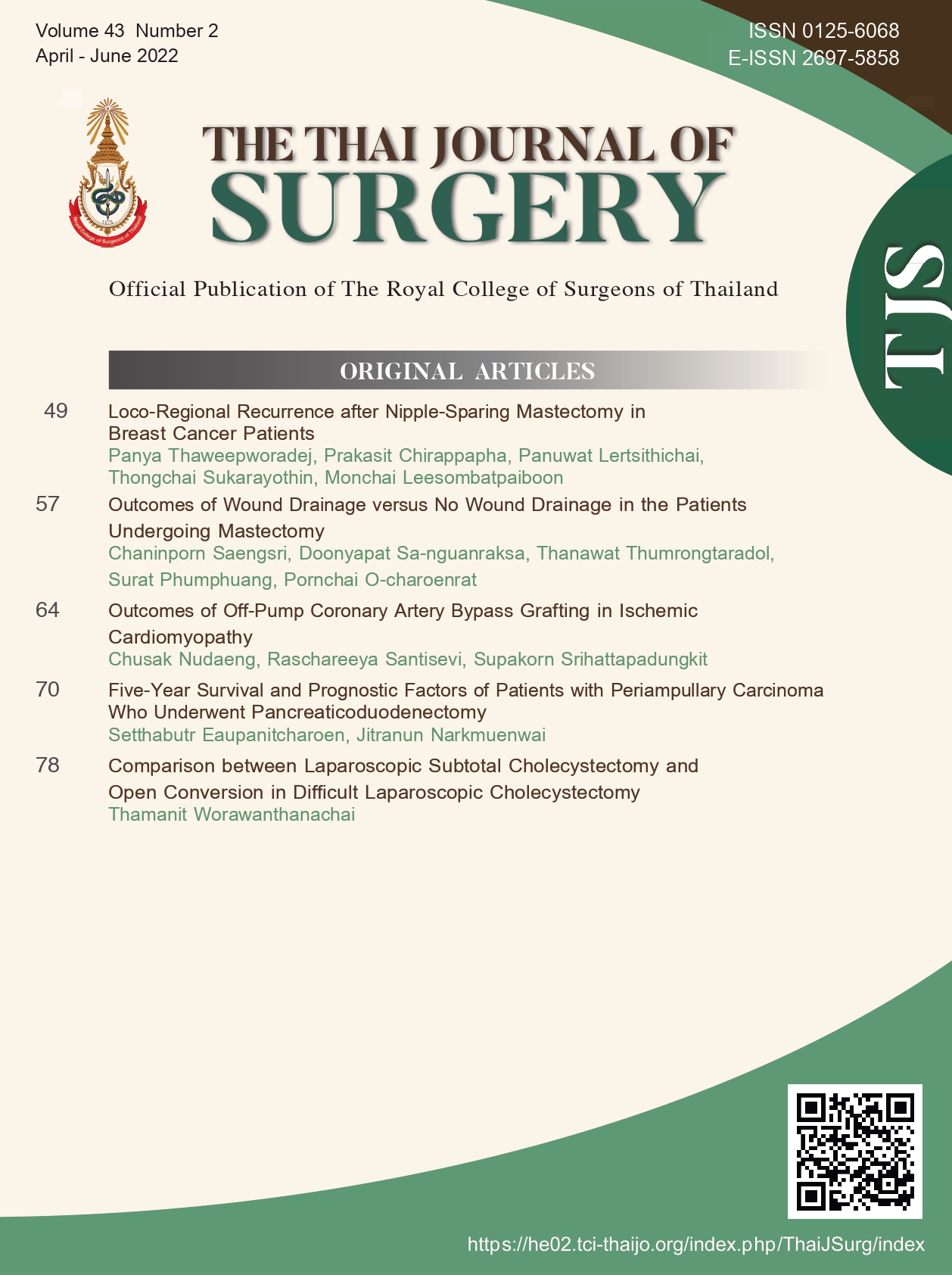Five-Year Survival and Prognostic Factors of Patients with Periampullary Carcinoma Who Underwent Pancreaticoduodenectomy
Keywords:
Periampullary carcinoma, Pancreaticoduodenectomy, Survival rateAbstract
Objective: Periampullary carcinomas are defined as tumors that arise within 2 cm of the major papilla. The pancreaticoduodenectomy is the standard curative treatment for these tumors. However, the long-term survival may vary due to many factors. This study aimed to identify prognostic factors and 5-year survival of periampullary carcinoma; and to evaluate the surgical outcomes of a pancreaticoduodenectomy.
Patients and Methods: We conducted a retrospective review of the medical records of patients with periampullary carcinoma who underwent pancreaticoduodenectomy from January 2010 to December 2014 in a tertiary hospital. Patient characteristics, perioperative data and pathological data were analyzed. Univariate and multivariate analysis of prognostic factors for survival was analyzed by the Cox proportional hazard model. The Kaplan-Meier survival curve was used to describe survival rate. The P-value less than 0.05 was considered as statistically significant.
Results: Of 61 patients (with a median age of 58 years), cancer of the ampulla of Vater was the most common tumor. The 3-year and 5-year overall survival rates were 52.5% and 34.4%, respectively. The 30-day postoperative mortality rate was 4.9%. Median overall survival time is 37.4 months. The independent prognostic factors were lymphovascular invasion (hazard ratio (HR): 9.10, 95% confidence interval (95% CI): 2.51 to 32.96, p = < 0.001) and moderate or poor tumor differentiation (HR: 2.28, 95% CI: 1.08 to 4.84, p = 0.03).
Conclusion: In this study, the 5-year overall survival rate was 34.4%. Poor prognostic factors of periampullary carcinoma after pancreaticoduodenectomy included the presence of lymphovascular invasion and poor to moderate tumor differentiation.
References
Sarmiento JM, Nagorney DM, Sarr MG, et al. Periampullary cancers. Surg Clin North Am 2001;81:543–55.
Chan C, Quintanilla-Martinez L, Richaud-Patin Y, et al. Clinical behavior and prognostic factors of periampullary adenocarcinoma. Ann Surg 1995;222:632–7.
Diener MK, Knaebel HP, Heukaufer C, et al. A systematic review and meta-analysis of pylorus-preserving versus classical pancreaticoduodenectomy for surgical treatment of periampullary and pancreatic carcinoma. Ann Surg 2007;245:187–200.
Williams JL, Chan CK, Toste PA, et al. Association of histopathologic phenotype of periampullary adenocarcinomas with survival. JAMA Surg 2017;152:82–8.
Junrungsee S, Kittivarakul E, Ko-iam W, et al. Prognostic factors and survival of patients with carcinoma of the ampulla of Vater after pancreaticoduodenectomy. Asian Pac J Cancer Prev 2017;18:225–9.
Kositamongkol P, Kumjornkijbovorn T, Mahawithitwong P, et al. Outcome and prognostic factors for periampullary carcinoma after pancreaticoduodenectomy: a single tertiary center experience. J Med Assoc Thai 2020;103:61–7.
Khaomuangnoi J, Pamornsinlapathum T, Phadungwitthayakorn A, et al. Results and predictive factors for survival of periampullary cancer patients at Uttaradit hospital. Thai J Surg 2016;37:133–41.
Bouvet M, Gamagami RA, Gilpin EA, et al. Factors influencing survival after resection for periampullary neoplasms. Am J Surg 2000;180:13–7.
Cameron JL, Riall TS, Coleman J, Belcher KA. One thousand consecutive pancreaticoduodenectomies: Ann Surg 2006;244:10–15.
Yeo CJ, Sohn TA, Cameron JL, et al. Periampullary adenocarcinoma: analysis of 5-year survivors. Ann Surg 1998;227:821–31.
Yeo CJ, Cameron JL, Sohn TA, et al. Six hundred fifty consecutive pancreaticoduodenectomies in the 1990s: pathology, complications, and outcomes. Ann Surg 1997;226:248–60.
Takikawa T, Kikuta K, Hamada S, et al. Clinical features and prognostic impact of asymptomatic pancreatic cancer. Sci Rep 2022;12:4262. doi.org/10.1038/s41598-022-08083-6.
Kamarajah SK. Pancreaticoduodenectomy for periampullary tumours: a review article based on Surveillance, End Results and Epidemiology (SEER) database. Clin Transl Onco. 2018;20:1153–60.
Chen SC, Shyr YM, Chou SC, et al. The role of lymph nodes in predicting the prognosis of ampullary carcinoma after curative resection. World J Surg Oncol 2015;13:224. doi: 10.1186/s12957-015-0643-1.
Chen SC, Shyr YM, Wang SE. Longterm survival after pancreaticoduodenectomy for periampullary adenocarcinomas. HPB. 2013 Dec;15(12):951–7.
Gutierrez JC, Franceschi D, Koniaris LG. How many lymph nodes properly stage a periampullary malignancy? J Gastrointest Surg 2008;12:77–85.
Huebner M, Kendrick M, Reid-Lombardo KM, et al. Number of lymph nodes evaluated: prognostic value in pancreatic adenocarcinoma. J Gastrointest Surg 2012;16:920–6.
Sommerville CAM, Limongelli P, Pai M, et al. Survival analysis after pancreatic resection for ampullary and pancreatic head carcinoma: an analysis of clinicopathological factors. J Surg Oncol 2009;100:651–6.
Seren TD, Topgul K, Koca B, at al. Factors affecting survival in patients who underwent pancreaticoduodenectomy for periampullary cancers. Turk J Surg 2015;31:72–7.
Zakaria H, sallam AN, Ayoub II, et al. Prognostic factors for long-term survival after pancreaticoduodenectomy for periampullary adenocarcinoma. A retrospective cohort study. Ann Med Surg 2020;57:321–7.
Downloads
Published
How to Cite
Issue
Section
License
Copyright (c) 2022 The Royal College of Surgeons of Thailand

This work is licensed under a Creative Commons Attribution-NonCommercial-NoDerivatives 4.0 International License.
Articles must be contributed solely to The Thai Journal of Surgery and when published become the property of the Royal College of Surgeons of Thailand. The Royal College of Surgeons of Thailand reserves copyright on all published materials and such materials may not be reproduced in any form without the written permission.



